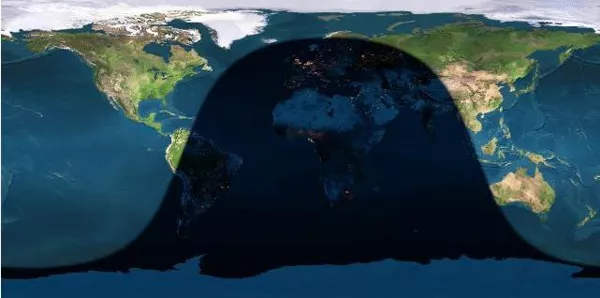View Other Topics.
 Jul 20, 2016
Jul 20, 2016
The Full Buck Moon –July is normally the month when the new antlers of buck deer push out of their foreheads in coatings of velvety fur. It was also often called the Full Thunder Moon, for the month's many thunderstorms frequent during this time. Another name for this month’s Moon was the Full Hay Moon after the July hay harvest.
EarthSky.com tells us this month, the full moon falls on July 19, 2016. In North America, we often call the July full moon the Buck Moon, Thunder Moon or Hay Moon. At this time of year, buck deer begin to grow velvety antlers, while farmers are struggling to put hay in their barns amid the sumer season’s frequent thunder showers.
The moon is said to be astronomically full when it’s precisely 180 opposite the sun in ecliptic longitude. This happens at 22:57 Universal Time. At US latitudes, that translates to 6:57 p.m. EDT, 5:57 p.m. CDT, 4:57 p.m. MDT and 3:57 p.m. PDT.
Strictly speaking, we in North America won’t see the moon at the instant that it turns full. For us, the moon will still be below the horizon as the moon turns exactly full. By the time the moon rises over the eastern horizon, we in North America will be looking at a moon that’s slightly past full phase. It’ll be a full-looking waning gibbous moon.
No matter. From almost everywhere worldwide, the moon will appear plenty full to the eye on the night of July 19-20. That’s because at the vicinity of full moon, the moon remains pretty much opposite the sun in Earth’s sky all hours of the night.
Look for the moon to rise in your eastern sky at dusk or early evening, to climb up highest up for the night around midnight and to sit low in your western sky at dawn July 20.
The full moon lies almost opposite the sun, so the path of the July full moon across the nighttime sky will resemble that of the January sun across the daytime sky. Therefore, far-northern regions of the globe won’t see the moon at all tonight. That’s because the July full moon, like the January sun, reside too far south on the sky’s dome to be seen from northern Arctic latitudes.
For the rest of us, though, we’ll see the moon lighting up our skies from dusk or early evening until dawn.
6:57 PM EDT
5:57 PM CDT
4:57 PM MDT
3:57 PM PDT
11:57 PM BDT
Image: earthsky.com
Tags:
#full#buck#moon,#full#hay#moon,#full#thunder#moon,#full#moon,#astrology,#starzpsychics.com,#starz#advisors
Full Buck Moon.

The Full Buck Moon –July is normally the month when the new antlers of buck deer push out of their foreheads in coatings of velvety fur. It was also often called the Full Thunder Moon, for the month's many thunderstorms frequent during this time. Another name for this month’s Moon was the Full Hay Moon after the July hay harvest.
EarthSky.com tells us this month, the full moon falls on July 19, 2016. In North America, we often call the July full moon the Buck Moon, Thunder Moon or Hay Moon. At this time of year, buck deer begin to grow velvety antlers, while farmers are struggling to put hay in their barns amid the sumer season’s frequent thunder showers.
The moon is said to be astronomically full when it’s precisely 180 opposite the sun in ecliptic longitude. This happens at 22:57 Universal Time. At US latitudes, that translates to 6:57 p.m. EDT, 5:57 p.m. CDT, 4:57 p.m. MDT and 3:57 p.m. PDT.
Strictly speaking, we in North America won’t see the moon at the instant that it turns full. For us, the moon will still be below the horizon as the moon turns exactly full. By the time the moon rises over the eastern horizon, we in North America will be looking at a moon that’s slightly past full phase. It’ll be a full-looking waning gibbous moon.
No matter. From almost everywhere worldwide, the moon will appear plenty full to the eye on the night of July 19-20. That’s because at the vicinity of full moon, the moon remains pretty much opposite the sun in Earth’s sky all hours of the night.
Look for the moon to rise in your eastern sky at dusk or early evening, to climb up highest up for the night around midnight and to sit low in your western sky at dawn July 20.
The full moon lies almost opposite the sun, so the path of the July full moon across the nighttime sky will resemble that of the January sun across the daytime sky. Therefore, far-northern regions of the globe won’t see the moon at all tonight. That’s because the July full moon, like the January sun, reside too far south on the sky’s dome to be seen from northern Arctic latitudes.
For the rest of us, though, we’ll see the moon lighting up our skies from dusk or early evening until dawn.
6:57 PM EDT
5:57 PM CDT
4:57 PM MDT
3:57 PM PDT
11:57 PM BDT
Image: earthsky.com
Share this article with friends!
Tags:
#full#buck#moon,#full#hay#moon,#full#thunder#moon,#full#moon,#astrology,#starzpsychics.com,#starz#advisors






